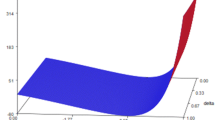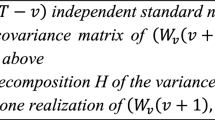Abstract
We apply a simple model to project the Solvency Capital Requirement (SCR) over several years, using an Own Risk Solvency Assessment (ORSA) perspective, in order to assess the probability of achieving a solvency coverage ratio. To do so, we rely on a simplified framework proposed in Guibert (Bulletin Français d’Actuariat 10(20), 2010) which provides a detailed explanation of the SCR. Then, we take into account temporal dynamics for liabilities, premiums and asset returns. Here, we consider guarantees in non-life insurance. This context, when simplified, allows us to use a lognormal distribution to approximate the distribution of the liabilities. It leads to a simple and tractable model for measuring the uncertainty of the solvency ratio in an ORSA perspective.








Similar content being viewed by others
Notes
This justifies index t and not t + 1.
In the case of a negative numerator with high probability (e.g. new product), this approximation can be applied by considering the opposite of the numerator.
A description of the general ORSA structure can be found in Planchet and Juillard [12].
References
Anderson TW, Darling DA (1954) A test of goodness of fit. JASA 49:765–769
Asmussen S, Albrecher H (2010) Ruin probabilities (second edn). In: Advanced series on statistical science and applied probability, vol 14, World Scientific, Singapore
Bera A, Jarque C (1980) Efficient tests for normality, heteroscedasticity and serial independence of regression residuals. Economic Letter 6:255–259
CEIOPS (2010a) Draft proposal for Level 3 Guidelines on Own Risk and Solvency Assessment, Consultation Paper
CEIOPS (2010b) QIS5 Technical Specifications, July 2010
Diers D (2009) Strategic management of assets and liabilities using multi-year internal risk models, American Risk and Insurance Association, Meeting Paper
Dufresne D (2004) The log-normal approximation in financial and other applications. Adv Appl Prob 36:747–773
El Faouzi NE, Maurin M (2006) Sur la loi de la somme de variables log-normales: application à la fiabilité de temps de parcours routiers, Working Paper, INRETS
Fenton LF (1960) The sum of log-normal probability distributions in scattered transmissions systems. IRE Trans Commun Syst 8:57–67
Guibert Q, Juillard M, Planchet F (2010) Un cadre de référence pour un modèle interne partiel en assurance de personnes. Bulletin Français d’Actuariat 10(20)
Liebwein P (2006) Risk models for capital adequacy: applications in the context of Solvency II and beyond. Geneva Pap 31:528–550
Planchet F, Juillard M (2010) Le Pilier 2: du calcul de l’exigence de marge au pilotage d’un profil de risqué, la Tribune de l’Assurance (rubrique «le mot de l’actuaire») (153), 01/12/2010
R Development Core Team (2011) R: A Language and Environment for Statistical Computting, R Foundation for Statistical Computing, Vienna, Austria. http://www.R-project.org
Robert CY (2011) Market value margin calculations under the cost of capital approach within a Bayesian chain ladder framework, ISFA, Working Paper
Saporta G (1990) Probabilités, analyse des données et statistique, Technip
Schwartz S (1982) On the distribution function and moments of power sums of with log-normal components. Bell Syst Tech J 61:1441–1462
Acknowledgments
The authors thank two referees whose comments have significantly improved this work. We also warmly thanks Pr. Ragnar Norberg for helpful comments and support.
Author information
Authors and Affiliations
Corresponding author
Appendix I
Appendix I
The calculation of the moments of the variable \( \chi_{t + 1} \) is presented in this Section for one or more lines of business.
1.1 For one line of business
Upstream of the presentation of the multiple- lines of business, we start by introducing the calculation of the moments of the variable \( \chi_{t + 1} \) in the presence of only one line of business.
Thanks to the following expression
we find the value of the conditional expectancy
Also, given that \( \varepsilon_{t + 1,\beta } \), \( \varepsilon_{t + 1,p} \), \( \varepsilon_{t + 1,l} \) are independent, we have the conditional variance
and thus, we deduce of (5) the coefficient of variation of \( (h_{t} + \theta ) \times BEL_{t + 1} - (1 + \theta \times \beta_{t + 1} ) \times P_{t + 1} \) is
1.2 For several lines of business
We continue with model containing several lines of business supposing the lognormal approximation is validated. First, we calculate the first two moments of the numerator of \( \chi_{t + 1} \), and then we deduce those of \( \chi_{t + 1} \). We have calculated the conditional expectation of the variable \( \sum\nolimits_{j = 1}^{n} {((h_{t} + \theta^{j} ) \times BEL_{t + 1}^{j} - (1 + \beta_{t + 1}^{j} \times \theta^{j} ) \times P_{t + 1}^{j} )} \)
and its conditional variance
The first component of the conditional variance is obtained simply
The second term is obtained by noting that the covariance of the two random lognormal variables \( (Y_{1} ,Y_{2} ) \) with parameters \( (\mu_{1} ,\sigma_{1} ) \) and \( (\mu_{2} ,\sigma_{2} ) \), respectively, are obtained from the covariance of the underlying normal variables \( (\varepsilon_{1} ,\varepsilon_{2} ) \)
\( Cov(Y_{1} ,Y_{2} ) = E(Y_{1} ) \times E(Y_{2} )(e^{{Cov\left( {\varepsilon_{1} ,\varepsilon_{2} } \right)}} - 1) \).
Denoting that the correlation coefficients \( \rho_{l}^{ij} \), \( \rho_{p}^{ij} \) and \( \rho_{\beta }^{ij} \) are associated with the variables \( (BEL_{t}^{i} ,BEL_{t}^{j} ) \), \( (C_{t}^{i} ,C_{t}^{j} ) \) and \( (\beta_{t}^{i} ,\beta_{t}^{j} ) \), respectively, we get
But we have
And
We then deduce
We finally infer the coefficient of variation of \( \sum\nolimits_{j = 1}^{n} {((h_{t} + \theta^{j} ) \times BEL_{t + 1}^{j} - (1 + \beta_{t + 1}^{j} \times \theta^{j} ) \times P_{t + 1}^{j} )} \)
and then the parameters of the lognormal approximation
As in the case of a single line of business (see Appendix I), the distribution of \( \chi_{t + 1} \) conditional on the information available at time t is approximated by a lognormal distribution with parameters
Rights and permissions
About this article
Cite this article
Planchet, F., Guibert, Q. & Juillard, M. Measuring uncertainty of solvency coverage ratio in ORSA for non-life insurance. Eur. Actuar. J. 2, 205–226 (2012). https://doi.org/10.1007/s13385-012-0051-7
Received:
Revised:
Accepted:
Published:
Issue Date:
DOI: https://doi.org/10.1007/s13385-012-0051-7




